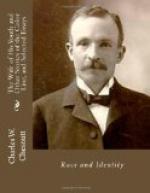The sheriff recalled his own youth. He had inherited an honored name to keep untarnished; he had had a future to make; the picture of a fair young bride had beckoned him on to happiness. The poor wretch now stretched upon a pallet of straw between the brick walls of the jail had had none of these things,—no name, no father, no mother—in the true meaning of motherhood,—and until the past few years no possible future, and then one vague and shadowy in its outline, and dependent for form and substance upon the slow solution of a problem in which there were many unknown quantities.
From what he might have done to what he might yet do was an easy transition for the awakened conscience of the sheriff. It occurred to him, purely as a hypothesis, that he might permit his prisoner to escape; but his oath of office, his duty as sheriff, stood in the way of such a course, and the sheriff dismissed the idea from his mind. He could, however, investigate the circumstances of the murder, and move Heaven and earth to discover the real criminal, for he no longer doubted the prisoner’s innocence; he could employ counsel for the accused, and perhaps influence public opinion in his favor. An acquittal once secured, some plan could be devised by which the sheriff might in some degree atone for his crime against this son of his—against society—against God.
When the sheriff had reached this conclusion he fell into an unquiet slumber, from which he awoke late the next morning.
He went over to the jail before breakfast and found the prisoner lying on his pallet, his face turned to the wall; he did not move when the sheriff rattled the door.
“Good-morning,” said the latter, in a tone intended to waken the prisoner.
There was no response. The sheriff looked more keenly at the recumbent figure; there was an unnatural rigidity about its attitude.
He hastily unlocked the door and, entering the cell, bent over the prostrate form. There was no sound of breathing; he turned the body over—it was cold and stiff. The prisoner had torn the bandage from his wound and bled to death during the night. He had evidently been dead several hours.
A Matter of Principle
I
“What our country needs most in its treatment of the race problem,” observed Mr. Cicero Clayton at one of the monthly meetings of the Blue Vein Society, of which he was a prominent member, “is a clearer conception of the brotherhood of man.”
The same sentiment in much the same words had often fallen from Mr. Clayton’s lips,—so often, in fact, that the younger members of the society sometimes spoke of him—among themselves of course—as “Brotherhood Clayton.” The sobriquet derived its point from the application he made of the principle involved in this oft-repeated proposition.
The fundamental article of Mr. Clayton’s social creed was that he himself was not a negro.




